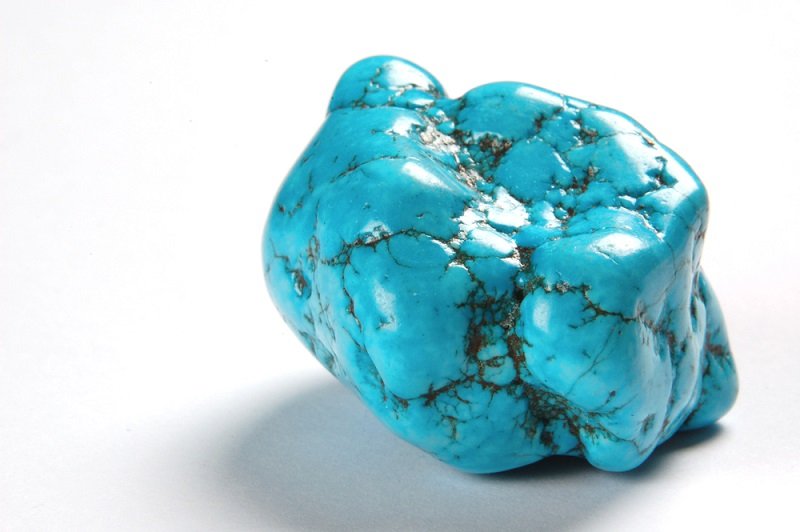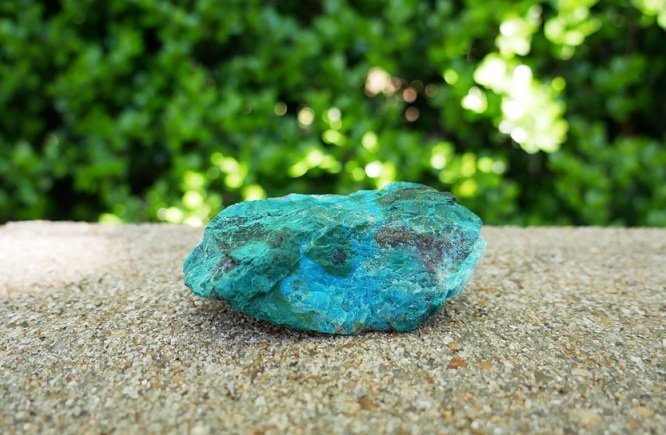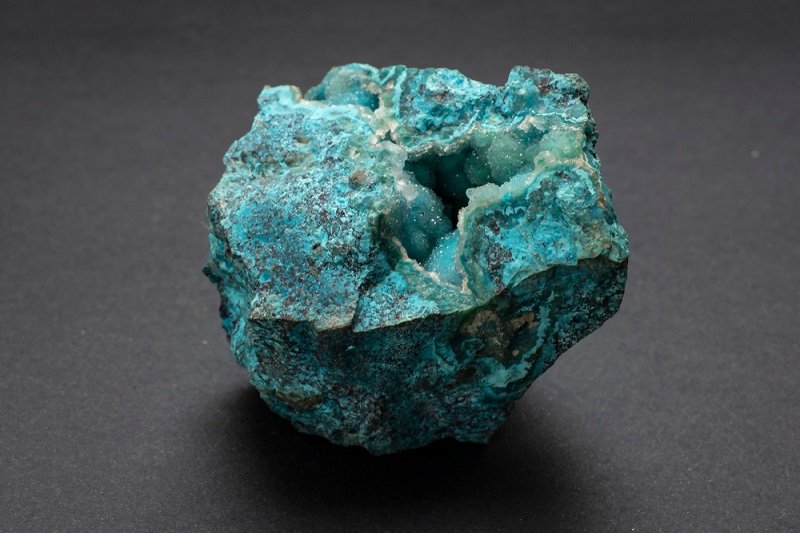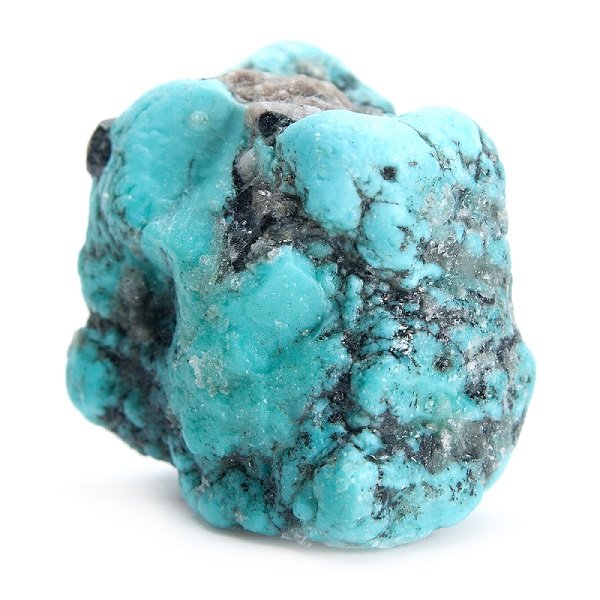Chrysocolla vs Turquoise
You are hiking in the southwest US and the hunt is on for interesting finds from the subcrops and scree slopes in front of you. The bright sun has reflected some color from a rock on the ground and you pick it up. Suddenly you have an exciting find.
The rock you hold in your hand is the size of a softball, but one corner of it is a beautiful turquoise in color. This mineral appears dense, has some weight, and there are no visible crystals.
The color and habit already suggest that this is likely turquoise or chrysocolla, both minerals which are well known in this part of the world.
Before you sort out which mineral you have, your (greedy) reflex action is to check the immediate area for more of the same. Not finding any, you return your attention to the rock in your hand and identification of its striking mineral.
Turquoise

Turquoise crystals are very rare; turquoise more commonly occurs as a dense, massive material. It can occur in fine-grained to cryptocrystalline masses (when one can not discern anything), and often occurs as veinlets or crust. Turquoise can also occur as a concretionary mineral. This mineral is an aluminum phosphate with copper, and has a high density of 2.6-2.8. If it is massive, it will have a conchoidal to smooth fracture.
Color Variation of Turquoise
It exhibits a range of colors: sky blue, bluish green to apple green; and has a hardness of 5-6. Those rare crystals will have a waxy, vitreous luster. On a tile it will give a white or greenish to pale green streak. It is brittle and may be translucent on thin edges.
Chrysocolla

Chrysocolla, on the other hand, is a copper silicate mineral, but has characteristics which bear many striking similarities to turquoise. The crystals are microcrystalline, and usually occur as vein-filling or as botryoidal masses. They may be opal-like in appearance. Extremely rare crystals, when they have been reported, are described as slender needles.
Color Variation of Chrisocolla
In terms of color, this mineral is similar to turquoise, ranging from sky-blue to greenish blue and green. However, chrysocolla is often streaked with black. It has a range of possible lusters: from glassy or dull to earthy. Its density of 2.0-2.4 is lower than turquoise. It similarly has a conchoidal fracture, and will be sectile to brittle.
Hardness
For your new specimen, the most important characteristic of chrysocolla is that it has a hardness between 2-4. A significantly softer mineral than turquoise. This leaves identification of your sample to a simple test with your pocket knife. Not wishing to needlessly carve up your new find, a small corner will suffice. If the knife (H=5.5) can not make a scratch, then you will most likely be holding turquoise.
I have to remind myself at these moments that this is a test of the resistance of the structure to mechanical deformation. So, it is good to not flex those muscles too much and crush the mineral with your knife blade – as that is another test altogether.
A caveat to your identification is that it is possible to find chrysocolla-impregnated chalcedony, or quartz, which will likewise be as hard as turquoise. Another test for normal chrysocolla is to lick the specimen: the tongue usually clings to the specimen. That’s entirely up to you.
If you want to do some destructive testing of your new find, there are laboratory tests which may be performed to identify your mineral. The best bet is to open your mineralogy
To compare and contrast turquoise and chrysocolla visually, you can take a good look at a variety of specimens of both minerals online at the Smithsonian: Just search for each mineral.
A Deeper Look at Chrysocolla vs Turquoise
Both turquoise and chrysocolla are secondary minerals, and both are usually found in arid regions.
Chrysocolla

Chrysocolla is an amorphous mineral which is an oxidation product of copper. The cryptocrystalline chrysocolla is carried and deposited as a colloid that will aggregate and then crystallize shortly after its deposition in a fractured space.
Chrysocolla is found with other secondary copper minerals such as cuprite and malachite. When in association with these other secondary minerals, it is mined as an ore of copper. Chrysocolla has been used for jewelry in the southwestern US, but when it is free of quartz it is too fragile for this use.
Chrysocolla occurs very widely in the American southwest in copper deposits, and many places in the world where oxidized copper minerals are included in the minerals mined for ore.
For example, in Australia, the large Mt. Isa Mine included chrysocolla in a long list of copper minerals mined for their copper ore; in Colorado, chrysocolla was mined from veins in the Creede Mine.
Related: Rockhounding In Arizona
Turquoise

Turquoise is found where rocks have been deeply altered. It usually forms veins in broken igneous rocks where phosphorus would be available from apatite in the country rock, alumina from the feldspar and copper from chalcopyrite grains.
New Mexico, Nevada and Colorado are all important turquoise states. Overseas, turquoise comes from Iran, Tibet and Chile.
In New Mexico, north of Interstate 40, the stretch of road which passes through the Cerillos Hills is referred to as the Turquoise Trail, where the mineral has been mined since prehistoric times.
Origins of Your Specimen
This is a good time to think about the provenance of your specimen. Where could it have originated and how did it arrive at the location where you found it?
Now you need to take a better look at that map you (hopefully) stuffed into your backpack, to see whether there are any indications of mining or prospecting in the area you are in.
A nearby copper mine, current or historical, might make you curious about the minerals being mined at that site for ore. If you are feeling pretty confident about your sample being turquoise, then it would be interesting to see whether there is any indication of such a prospect or mine on the map. This will likely be a small quarry and will require some hunting.
Be Aware of Fakes
Since you have recovered your specimen in the field, you can feel confident about the origin of the rock. However, hunting for a good specimen of turquoise or chrysocolla at a gem and mineral show will require an entirely different set of skills. We have already seen that chrysocolla can naturally impregnate chalcedony, and it is difficult to easily separate it from turquoise without destructive testing.
Read More: How To Tell If Turquoise Is Real Or Fake
Turquoise, as a gemstone, can have significant value. So it follows that there will be specimens which have been enhanced to exhibit the look and feel of turquoise.
Turquoise, or other minerals, can be treated to make them stronger, or dyed to achieve a preferred color. There is a great deal to be learned about this topic, so it is best to do your research before you go shopping for a new mineral specimen or jewelry.
- Online rock and mineral club for collectors of all levels!
- Find community with like-minded rock and mineral enthusiasts.
- Monthly Giveaways!
- Free Access to Entire Digital Library of Products (annual memberships)


